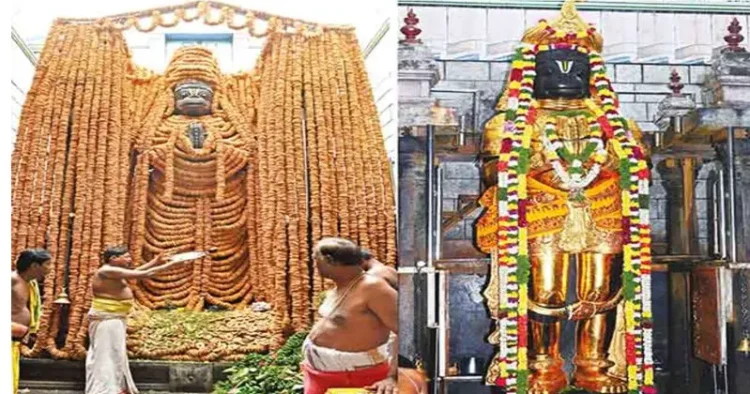Devotees thronged temples across Tamil Nadu to celebrate Hanumath Jayanti, an auspicious occasion observed during Margashirsha Amavasya and Moolam Nakshatram. This year, the auspicious occassion coincided with the full moon day (Amavasya) of the Tamil month Margashirsha, also known as Dhanu and the Moolam star. In Tamil tradition, Hanuman Jayanti is observed on this specific astrological alignment, making the celebration even more momentous.
Legend has it that Bhagwan Hanuman, the revered monkey god known for his devotion to Bhagwan Rama, was born on Margashirsha Amavasya under the Moolam star. While this alignment doesn’t always occur each year, when it does, it adds a layer of special significance to the festivities.
Thousands of devotees woke up before dawn to offer prayers and abhishekam (sacred offerings) to the murtis of Hanuman, which are adorned with fresh flowers and vibrant garlands. Temples across the state, particularly the prominent Hanuman temples in Nanganallur, Namakkal, and Suchindram, buzzed with activity throughout the day.
Many devotees observed fasts and participated in special pujas and kirtans in honour of Hanuman’s legendary strength, unwavering loyalty, and boundless devotion. The chanting of devotional songs like “Hanuman Chalisa” and the rhythmic beating of drums filled the air, created a powerful and uplifting atmosphere.
Tamil Nadu’s Hanuman Jayanti celebrations extend beyond temples, with street processions and cultural performances adding to the festive cheer. Food stalls offering prasad and traditional sweets also lined the streets, reflecting the spirit of community and sharing.
Hanuman Jayanti holds immense significance among the Hindu devotees, as they believe that worshipping the deity brings courage, zeal, and relief from hardship. The Brahmacharis (bachelors), wrestlers, and bodybuilders consider this day particularly auspicious, seeking Bhagwan Hanuman’s blessings for strength and success.
Devotees across India visit temples bearing fruits, sindoor, and flowers, participating in rituals like abhishekams (sacred baths) and chanting Hanuman Chalisa and other devotional songs.
Bhagwan Hanuman, recognized as one of the Sapt Chiranjivi (living forever) and a Brahmachari (unmarried), is believed to bless those chanting “Ram Ram” or “Jai Sri Ram” and fulfill their wishes.
Bhagwan Hanuman, known by various names such as Pavanasuta, Marutsuta, Mahavira, Bajrangabali, and more, Hanuman is revered as the avatar of Bhagwan Shiva. Devotees engage in nama sankeerthanam and bhajans during Hanuman Jayanthi, invoking divine blessings.
In temples nationwide, devotees presented fruits and sindoor to the idol of Bhagwan Hanuman. In Namakkal, a special celebration unfolded at the Anjaneya temple, where an 18-foot-tall deity received elaborate abhishekams. The festivities included adorning the deity with a mala comprising 1,00,008 crispy vadas, culminating in a special arathi.
Priests overseeing the ceremony in Namakkal shared that materials worth Rs 20 lakh, including 2,200 kg of black gram flour, 600 liters of gingelly oil, 33 kg of pepper, and 125 kg of salt, were utilised to prepare the vadas. This meticulous attention to ritualistic details highlighted the devotion and reverence with which devotees marked Hanuman Jayanthi.
Devotees thronged Hanuman temples across Tamil Nadu, immersing themselves in the auspicious celebrations of Hanumath Jayanti. Notable temples, including Sri Guru Hanuman Temple, Anumandaeswar Temple, Sri Kubera Anjaneyar Temple, and Sri Sanjeevaray Hanuman Temple in Coimbatore, witnessed a large influx of devotees seeking blessings from Bhagwan Hanuman.
In the city of Chennai, devotees gathered at Alwarpet’s Anjaneya Swamy Temple, Pudupakkam’s Veera Anjaneyar, and Ashok Nagar’s Anjaneyar Temple, embracing the divine atmosphere. Other temples such as Suchindram Hanuman Temple (22 feet) and Nangallur Anjaneyar Temple (32 feet tall) drew devotees in large numbers from different parts of the region.
Hanuman Jayanti, observed during Chaitra Purnima, is especially popular in North Indian states, known as Hanuman Jayanti. Celebrated on the full moon day during the Chaitra month, this occasion marks the birth of Bhagwan Hanuman, revered as the Vanara God. In Andhra Pradesh and Telangana, devotees embark on a 41-day Deeksha, starting from Chaitra Purnima and concluding on the tenth day during Krishna Paksha in the Vaishakha month.
Devotees across these regions adhere to their regional beliefs and follow distinct calendars, observing Hanumath Jayanthi at different times of the year. The celebrations exemplify the deep spiritual connection people share with Bhagwan Hanuman, with a multitude seeking blessings and participating in the joyous festivities at these exclusive temples.
This year’s Hanuman Jayanti in Tamil Nadu was a vibrant and joyous affair, reaffirming the immense popularity and enduring devotion towards this beloved deity. The day served as a reminder of Hanuman’s timeless values of courage, selflessness, and unwavering faith, qualities that continue to inspire millions of devotees across generations.




















Comments